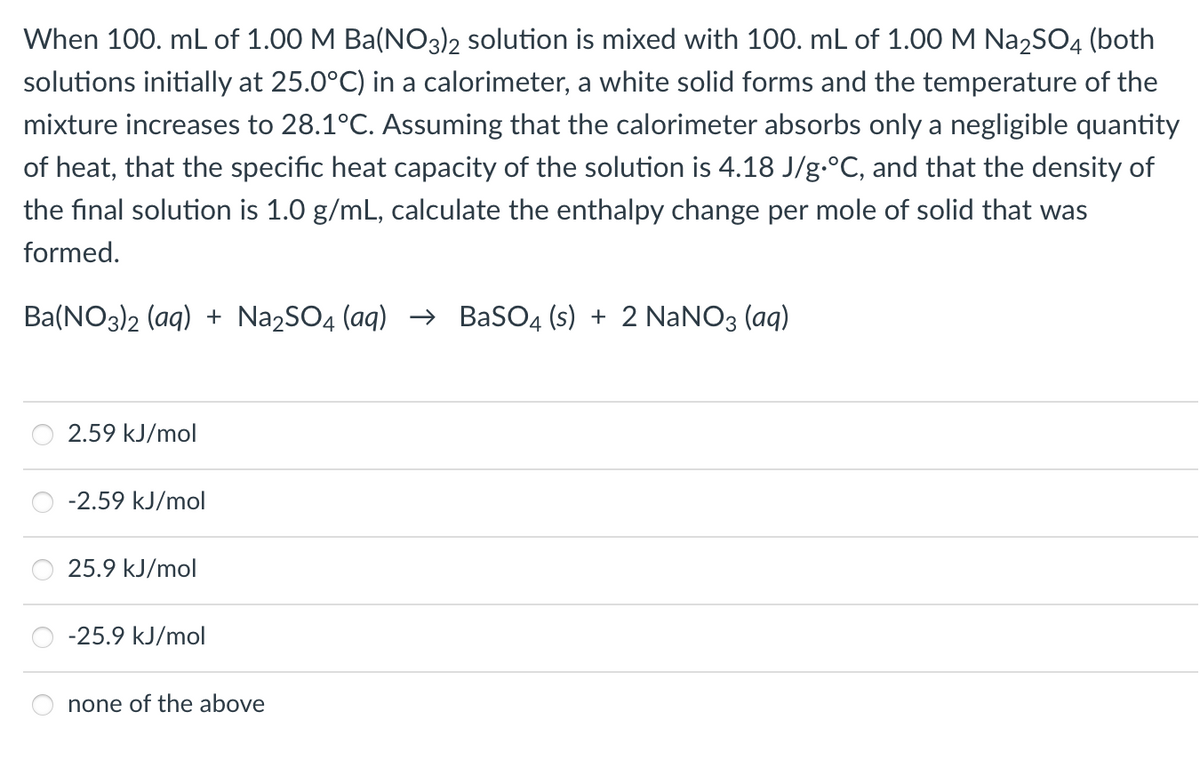When 100. mL of 1.00 M Ba(NO3)2 solution is mixed with 100. mL of 1.00 M Na₂SO4 (both solutions initially at 25.0°C) in a calorimeter, a white solid forms and the temperature of the mixture increases to 28.1°C. Assuming that the calorimeter absorbs only a negligible quantity of heat, that the specific heat capacity of the solution is 4.18 J/g.°C, and that the density of the final solution is 1.0 g/mL, calculate the enthalpy change per mole of solid that was formed. Ba(NO3)2 (aq) + Na₂SO4 (aq) → BaSO4 (s) + 2 NaNO3(aq) 2.59 kJ/mol -2.59 kJ/mol 25.9 kJ/mol -25.9 kJ/mol none of the above
When 100. mL of 1.00 M Ba(NO3)2 solution is mixed with 100. mL of 1.00 M Na₂SO4 (both solutions initially at 25.0°C) in a calorimeter, a white solid forms and the temperature of the mixture increases to 28.1°C. Assuming that the calorimeter absorbs only a negligible quantity of heat, that the specific heat capacity of the solution is 4.18 J/g.°C, and that the density of the final solution is 1.0 g/mL, calculate the enthalpy change per mole of solid that was formed. Ba(NO3)2 (aq) + Na₂SO4 (aq) → BaSO4 (s) + 2 NaNO3(aq) 2.59 kJ/mol -2.59 kJ/mol 25.9 kJ/mol -25.9 kJ/mol none of the above
Chemistry: An Atoms First Approach
2nd Edition
ISBN:9781305079243
Author:Steven S. Zumdahl, Susan A. Zumdahl
Publisher:Steven S. Zumdahl, Susan A. Zumdahl
Chapter7: Chemical Energy
Section: Chapter Questions
Problem 100AE
Related questions
Question

Transcribed Image Text:When 100. mL of 1.00 M Ba(NO3)2 solution is mixed with 100. mL of 1.00 M Na₂SO4 (both
solutions initially at 25.0°C) in a calorimeter, a white solid forms and the temperature of the
mixture increases to 28.1°C. Assuming that the calorimeter absorbs only a negligible quantity
of heat, that the specific heat capacity of the solution is 4.18 J/g °C, and that the density of
the final solution is 1.0 g/mL, calculate the enthalpy change per mole of solid that was
formed.
Ba(NO3)2 (aq) + Na₂SO4 (aq) → BaSO4 (s) + 2 NaNO3(aq)
2.59 kJ/mol
-2.59 kJ/mol
25.9 kJ/mol
-25.9 kJ/mol
none of the above
Expert Solution
This question has been solved!
Explore an expertly crafted, step-by-step solution for a thorough understanding of key concepts.
This is a popular solution!
Trending now
This is a popular solution!
Step by step
Solved in 3 steps with 3 images

Knowledge Booster
Learn more about
Need a deep-dive on the concept behind this application? Look no further. Learn more about this topic, chemistry and related others by exploring similar questions and additional content below.Recommended textbooks for you

Chemistry: An Atoms First Approach
Chemistry
ISBN:
9781305079243
Author:
Steven S. Zumdahl, Susan A. Zumdahl
Publisher:
Cengage Learning

Chemistry
Chemistry
ISBN:
9781305957404
Author:
Steven S. Zumdahl, Susan A. Zumdahl, Donald J. DeCoste
Publisher:
Cengage Learning


Chemistry: An Atoms First Approach
Chemistry
ISBN:
9781305079243
Author:
Steven S. Zumdahl, Susan A. Zumdahl
Publisher:
Cengage Learning

Chemistry
Chemistry
ISBN:
9781305957404
Author:
Steven S. Zumdahl, Susan A. Zumdahl, Donald J. DeCoste
Publisher:
Cengage Learning


Chemistry for Engineering Students
Chemistry
ISBN:
9781337398909
Author:
Lawrence S. Brown, Tom Holme
Publisher:
Cengage Learning

Chemistry: Principles and Practice
Chemistry
ISBN:
9780534420123
Author:
Daniel L. Reger, Scott R. Goode, David W. Ball, Edward Mercer
Publisher:
Cengage Learning

Principles of Modern Chemistry
Chemistry
ISBN:
9781305079113
Author:
David W. Oxtoby, H. Pat Gillis, Laurie J. Butler
Publisher:
Cengage Learning